If you teach science to English language learners (ELLs), you may be wondering how best to support their instruction in your classroom. The good news is that there are lots of ideas you can put into practice right away and that many of these ideas will also support success for all students.
We have several tips for you in this article, along with links to recommended resources for further exploration. We have also included reflection questions you can use in your planning or in discussion with your team.
Getting to Know Your Students
ELL Tips for Science Teachers
Before jumping into lesson planning, we can't overestimate the importance of getting to know your students. Not only does this provide valuable information that can help inform instruction, but it creates a stronger relationship that can foster student confidence and independence in the classroom. Here are some things to focus on:
- Making students feel welcome: Welcome students with smiles, friendly greetings, and positive body language. Show respect for students' languages and cultures, and learn to say and write students' names correctly. Refrain from using nicknames or making comments about students' names.
- Student interests: Getting to know your students' interests can provide a springboard for connections to science content, such as sports, baking, wildlife, or technology.
- Daily connections to science: Although we don't always "see" science, there are lots of connections you can make to daily experiences. The better you know your students, the more effectively you can make these connections. For example, students may know a lot about gardening or agriculture or be responsible for fixing equipment at a job. Students may take medication or help administer medication to relatives. And students are probably responsible for tech support at home!
- Students' prior schooling: Students' educational experiences may vary widely. While some students may have had consistent schooling, others may have had limited or interrupted schooling. Learning more about your students' past educational experiences will help you identify areas of knowledge they have or need.
- Students' language proficiency levels: Your students may have different levels of English language proficiency, and those levels may also vary by skill. For example, a student may be stronger in speaking than writing, or stronger in reading than speaking. Understanding this data can help you target your instruction more effectively.
Reflection Questions
- How much science instruction have your ELLs received in their prior schooling?
- How much do their levels of science background vary?
- What are some of their strengths related to science? What are some of their challenges?
- What are some practical ways your ELLs are using science in their daily lives?
- What are some of your students' interests?
Planning Your Science Lesson
Here are some high-impact areas to focus on as you look at how to support ELLs in your science instruction. You can also ask ELL colleagues, such as ESL teachers or specialists, for their ideas or guidance in trying these ideas.
1. Identify target content, background knowledge, and skills.
- Target Content: As you prepare your lesson plan, identify key content and concepts students will need to learn. What connections can you make to other content or students' experiences?
- Background Knowledge: Are there important areas of background knowledge that students already have? Are there topics where you may need to build background knowledge? You can find out what students know about certain topics by using graphic organizers such as K-W-L charts and concept maps.
- Key Skills: What key skills do students need to learn, such as measuring or making observations? Provide clear, step-by-step instructions in writing for new activities.
Note: One strategy you can use to prepare students for new material is pre-teaching vocabulary and content. See an example of this in action in the "Super Secret Science Club" vignette below.
2. Identify key vocabulary.
What key vocabulary words do students need to know in your lesson?
- Academic words (photosynthesis, electron, plankton)
- Words with multiple meanings (uniform, class, desert, gas, table)
- Words needed to describe a process (observe, effect)
- Words needed in a lab report or experiment (hypothesis, conclusion)
- Homophones (cell/sell, weight/wait, son/sun, pistil/pistol)
- Words that students are likely to encounter in other settings (formula, prove)
- Measurement words (foot, feet, meter, grams, pounds, kilometers)
You can teach these words through glossaries, user-friendly definitions, visuals, and sample sentences. Keep in mind that students need lots of opportunities to practice new words in reading, writing, speaking, and listening. You can see several ideas in our vocabulary-focused strategies from our ELL Strategy Library.
Connecting to Students' Languages
Students' languages are a valuable resource for instruction — even if you don't speak those languages! By learning how to make connections to students' languages, you can tap into content knowledge and vocabulary that they may already know.
- Use multilingual glossaries, which may already exist in your content area. You can also invite students to create their own.
- Use cognates, which are related words in two languages (e.g., the English-Spanish pair biology/biología).
- Invite students to add labels to annotated diagrams in their languages and review their diagrams with a partner who speaks their language.
- You can also encourage students to brainstorm, write ideas, or hold discussions in their own languages and then share their findings in English.
3. Identify language-based tasks.
Academic language is the language of school and content-area instruction. ELLs may need additional explicit instruction to develop academic language, but this instruction can benefit all students.
For example, there are all kinds of language-based tasks that students are expected to complete in science class, such as:
- Reading a non-fiction article
- Writing a lab report
- Describing an experiment
As you read through the following tips, think about the language tasks students are expected to complete. What will those tasks look like when they are completed successfully? Here are some ways to help students meet that goal:
- Use sentence frames to model key phrases students need to say or write, such as, "___________ is a __________." (Water is a liquid.)
- Break language-focused tasks, such as describing a scientific process, into steps. Focus on one step at a time.
- Share examples of the different types of writing or formats students are expected to use. For example, if students must write a prediction, share samples of sample predictions. Point out key features and phrases used in the sample. (If you don't have samples readily available, you can use Artificial Intelligence, or AI, to generate sample texts around certain topics and at different reading levels. This is one way you can differentiate for different language proficiency levels.)
- Pay attention to students' writing and speaking in class. What are some areas in which they need additional practice?
- Keep in mind that writing may provide additional challenges, even if students can discuss and describe something accurately. For more ideas on supporting writing in science, see our in-depth article Teaching Writing in the Content Areas: Research to Practice.
- Give students extra practice with discussion and presentation through peer learning activities, such as accountable talk.
- Use language objectives, which help target the language demands of the lesson. You can learn more about them in the videos featuring Mr. Jesus Ortiz below.
4. Use hands-on learning.
There are lots of ways you can bring hands-on learning to the science classroom, which can engage all students, including ELLs. These include:
- Project-based and inquiry-based learning
- Science activities in the school, community, or neighborhood (such as a school garden, neighborhood clean-up, or citizen scientist project)
- Field trips to parks, museums, universities, and other sites
- Guest speakers who use science in their jobs, such as health professionals, public works employees, chefs, and engineers
- Using books for children, middle grades, and young adults (see booklists below)
Student Input
In addition, look for ways to engage students by teaching them to use strategies independently and asking them to pay attention to what supports their learning. You can learn a lot by asking students what is working (or not!).
For example, in Long-Term Success for Experienced Multilinguals, ELL experts Beth Skelton and Tan Huynh share the following student response to the question, “What is your favorite class?” One student responded with the following:
Biology is my favorite class because I love learning about science. I want to study medicine after high school. The teacher gives step-by-step directions for every project so I know exactly how to complete it. She also labels pictures and explains the concepts clearly. (p. 49)
5. Try co-planning your lessons.
If you haven't collaborated with your ELL colleagues before, it's ok to start small! They have valuable expertise and can help share ideas about how to support language development in the science classroom.
For example, you could try co-planning a lesson, working together to identify:
- Target content: Key standards, concepts, topics, skills, or background knowledge
- Target language: Key vocabulary, academic language, and the language-focused tasks students will need to complete the lesson
The ELL specialist could walk the science teacher through this process several times so that it becomes a more integral part of the science teacher's planning over time. After the lesson, the teachers could identify other areas of focus or clarification needed and share these insights with their colleagues.
Co-Teaching Science Lessons
If possible, you may also wish to try co-teaching a lesson with your ELL colleague. There are several ways to approach this. For example, an ELL teacher may work with a small group of ELLs during a lesson, or the ELL teacher may deliver a mini lesson on key vocabulary to the whole class. If you'd like ideas, see Co-Teaching ELLs: 8 Strategies for Success. Informal collaboration can also pave the way for more formal collaboration time, which can benefit students and educators alike.
Reflection Questions
- What ideas would you like to try from these tips?
- What kinds of strategies have been successful with your students in the past?
- Think about your own experiences in science class. Did you have models, examples, or explicit instruction from teachers in terms of the language or format you used for assignments?
Sample Scaffolds and Strategies
There are several ways you can scaffold new content and vocabulary. For example, let's say you are teaching the water cycle. You could try the following:
| Activity | Sample Strategy |
|---|---|
| |
| |
|
For additional ideas, see this list of strategies from our ELL Strategy Library, which can be used to support science instruction for all grades:
| Bringing Content to Life | Reading & Writing | Using Data | Checking Understanding |
|---|---|---|---|
Strategies: | Strategies: | Strategies: | Strategies: |
Related Videos
ELLs Belong to All of Us: The Role of ESOL Specialists in Collaboration
ESOL specialist Katy Padilla plays a key role in advocating for ELLs throughout the lesson planning process and sharing her strategies for engaging and supporting students.
How to Write Language Objectives: Tips for ELL Educators
In this video from Syracuse, NY, Jesus Ortiz, a bilingual teacher, learns how to write a language objective from Areli Schermerhorn, a peer evaluator with expertise in ELL and bilingual education.
Coaching Conversations: Supporting New Teachers of ELLs
This video from Syracuse, NY highlights the coaching relationship between a first-year teacher, Alexandra Galán, and two ELL coaches, Erica Daniels and Lillian Zayas. The coaches and teacher discuss a science lesson the coaches have observed.
Building a cereal dispenser with ELLs through the Rube Goldberg project
4th-grade teacher Michelle Iadevaia tells the story of her English learners' efforts to build a cereal dispenser through the Rube Goldberg project.
Recommended Resources
Articles
- Opportunities and Challenges for ELLs in the Science Inquiry Classroom (Part 1)
- Communication and Language Strategies for the Science Inquiry Classroom (Part 2)
- Next Generation Science Standards: Offering Equitable Opportunities for ELLs to Engage in Science
- Rethinking Language Goals in Science with Three-Dimensional Learning
- Supporting ELL Instruction with AI: Ideas for Educators
Booklists
- Animals: Bilingual Books for Kids
- Earth Science: Bilingual Books for Kids
- Insects: Bilingual Books for Kids
- Oceans: Bilingual Books for Kids
- Plants: Bilingual Books for Kids
- Reptiles, Amphibians, and Dinosaurs: Bilingual Books for Kids
- Seasons, Weather, and Time
- Science Fun: Books for Kids
- Science, Nature, and the Outdoors
- Stars, Planets, and Space: Diverse Books for Kids
- The Magic of Butterflies
- Women in Science and Math
- Middle Grade and Young Adult Titles: Nature and the Outdoors
- Middle Grade and Young Adult Titles: STEM

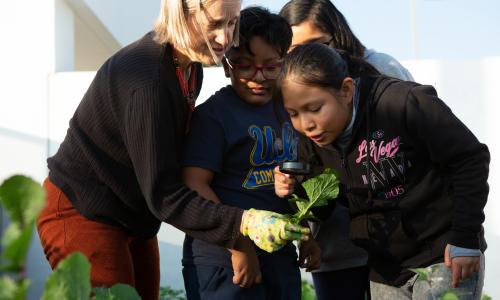
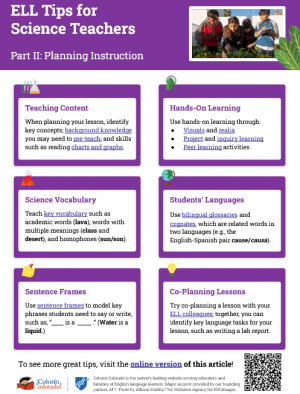
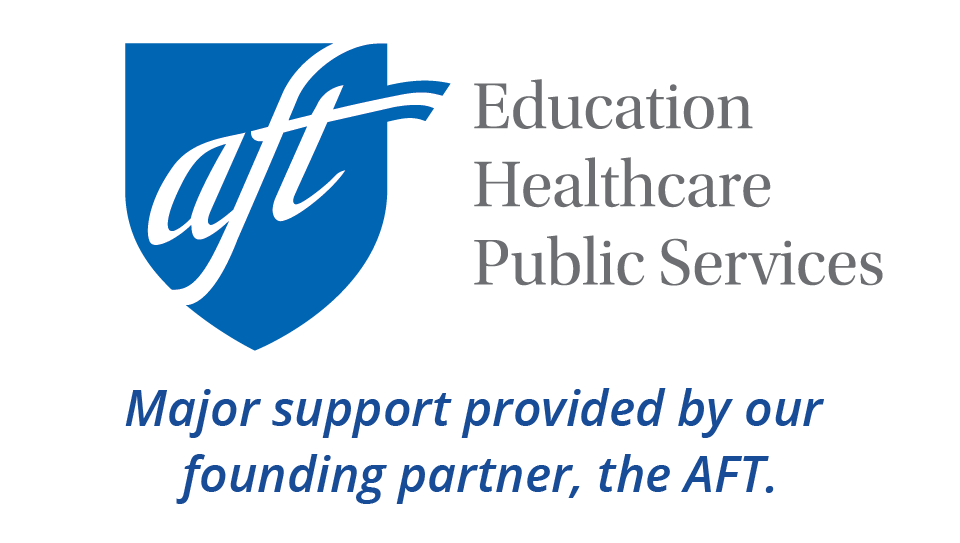
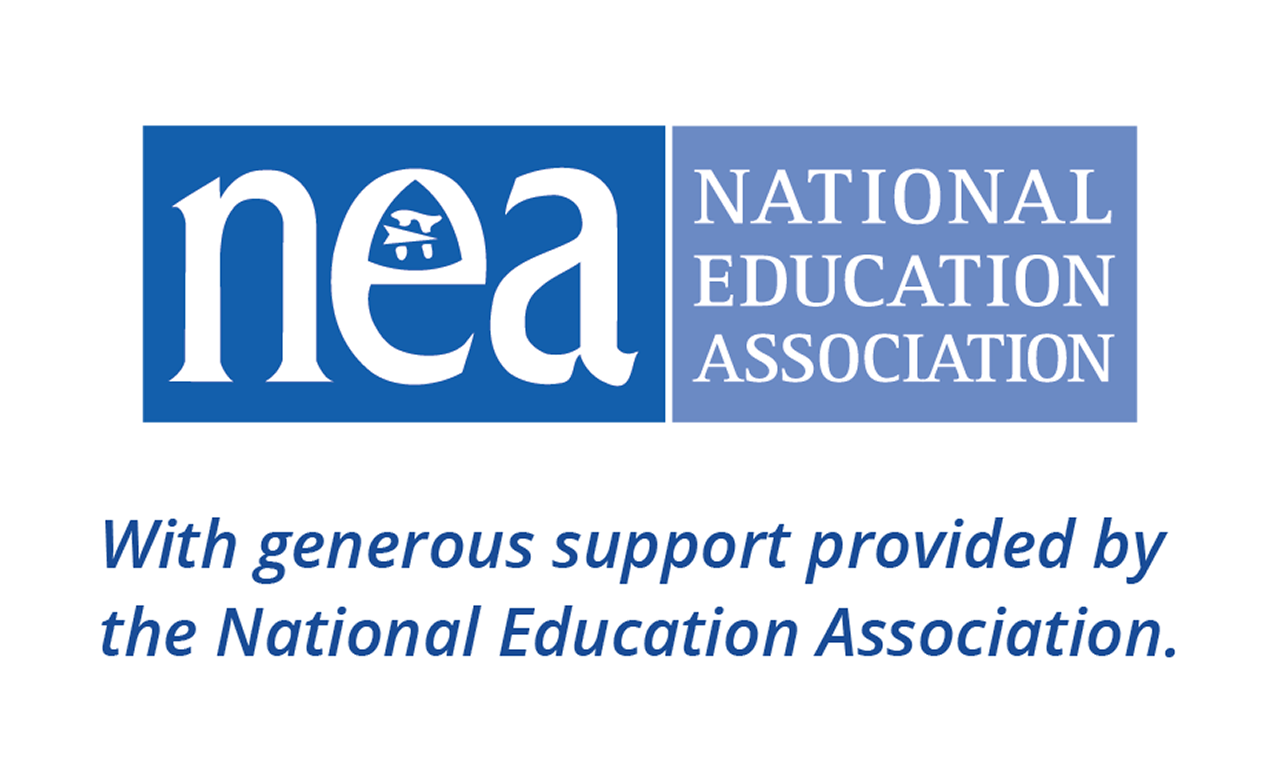
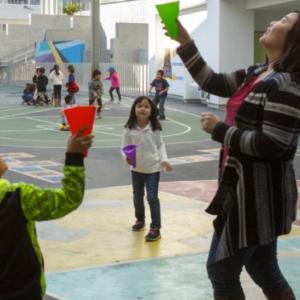
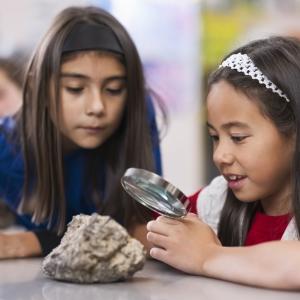

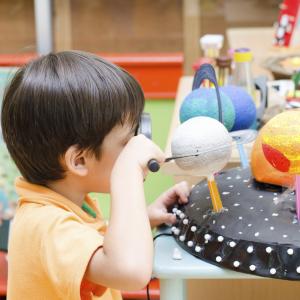
Add new comment